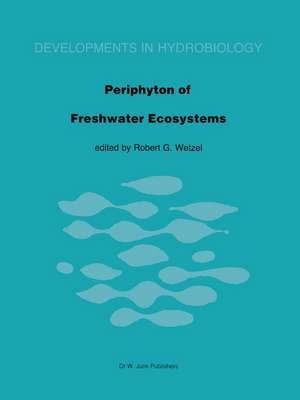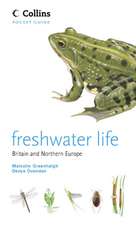Periphyton of Freshwater Ecosystems: Proceedings of the First International Workshop on Periphyton of Freshwater Ecosystems held in Växjö, Sweden, 14–17 September 1982: Developments in Hydrobiology, cartea 17
Editat de R.G. Wetzelen Limba Engleză Paperback – 6 oct 2011
Din seria Developments in Hydrobiology
- 18%
 Preț: 1229.10 lei
Preț: 1229.10 lei - 18%
 Preț: 959.98 lei
Preț: 959.98 lei - 18%
 Preț: 963.91 lei
Preț: 963.91 lei - 15%
 Preț: 648.24 lei
Preț: 648.24 lei - 15%
 Preț: 637.89 lei
Preț: 637.89 lei -
 Preț: 378.25 lei
Preț: 378.25 lei - 15%
 Preț: 644.95 lei
Preț: 644.95 lei - 18%
 Preț: 952.09 lei
Preț: 952.09 lei - 20%
 Preț: 558.87 lei
Preț: 558.87 lei - 18%
 Preț: 1833.65 lei
Preț: 1833.65 lei -
 Preț: 393.59 lei
Preț: 393.59 lei -
 Preț: 406.54 lei
Preț: 406.54 lei - 18%
 Preț: 1226.73 lei
Preț: 1226.73 lei - 18%
 Preț: 956.99 lei
Preț: 956.99 lei -
 Preț: 388.87 lei
Preț: 388.87 lei - 24%
 Preț: 1060.53 lei
Preț: 1060.53 lei - 18%
 Preț: 1229.28 lei
Preț: 1229.28 lei - 20%
 Preț: 569.31 lei
Preț: 569.31 lei -
 Preț: 368.79 lei
Preț: 368.79 lei - 24%
 Preț: 817.48 lei
Preț: 817.48 lei - 18%
 Preț: 958.25 lei
Preț: 958.25 lei - 18%
 Preț: 953.03 lei
Preț: 953.03 lei -
 Preț: 384.75 lei
Preț: 384.75 lei - 24%
 Preț: 1582.95 lei
Preț: 1582.95 lei - 24%
 Preț: 1051.70 lei
Preț: 1051.70 lei - 18%
 Preț: 943.57 lei
Preț: 943.57 lei - 18%
 Preț: 1235.76 lei
Preț: 1235.76 lei - 24%
 Preț: 800.05 lei
Preț: 800.05 lei - 24%
 Preț: 803.57 lei
Preț: 803.57 lei - 18%
 Preț: 948.29 lei
Preț: 948.29 lei
Preț: 958.25 lei
Preț vechi: 1168.60 lei
-18% Nou
Puncte Express: 1437
Preț estimativ în valută:
183.37€ • 196.08$ • 152.88£
183.37€ • 196.08$ • 152.88£
Carte tipărită la comandă
Livrare economică 18 aprilie-02 mai
Preluare comenzi: 021 569.72.76
Specificații
ISBN-13: 9789400972957
ISBN-10: 9400972954
Pagini: 360
Ilustrații: 356 p.
Dimensiuni: 210 x 280 x 19 mm
Greutate: 0.81 kg
Ediția:Softcover reprint of the original 1st ed. 1983
Editura: SPRINGER NETHERLANDS
Colecția Springer
Seria Developments in Hydrobiology
Locul publicării:Dordrecht, Netherlands
ISBN-10: 9400972954
Pagini: 360
Ilustrații: 356 p.
Dimensiuni: 210 x 280 x 19 mm
Greutate: 0.81 kg
Ediția:Softcover reprint of the original 1st ed. 1983
Editura: SPRINGER NETHERLANDS
Colecția Springer
Seria Developments in Hydrobiology
Locul publicării:Dordrecht, Netherlands
Public țintă
ResearchCuprins
Opening speech.- Opening remarks.- I. Dynamics of Periphytic Communities.- 1. Dynamics of periphytic communities.- 2. Seasonal changes in the taxonomic composition of epiphytic algal communities in Lake Wingra, Wisconsin, U.S.A..- 3. A comparison of the periphytic communities in two sections of the Danube River.- 4. Phytosociological associations of algal periphyton.- 5. Development and dynamics of floating clusters of filamentous algae.- 6. A comparison of the periphyton of Nuphar lutea and Nymphaea alba. The distribution of diatoms on the undersides of floating leaves.- 7. Structural investigations of periphytic protozoan communities in three layers of the Danube River. I. The question of stratification.- 8. Structural investigations of periphytic protozoan communities in three layers of the Danube River. II. The course of colonization.- 9. Seasonal changes in diatom-structure of periphyton from two localities in Lake Maarsseveen: community indices.- II. Parameters Influencing Growth of Periphyton.- 10. Physical and chemical parameters regulating growth of periphytic communities.- 11. Photosynthesis-irradiance relationships of epilithic algae measured in the laboratory and in situ.- 12. Selective light attenuation by the periphyton complex.- 13. Influence of current velocity on periphyton distribution.- 14. Nitrogen fixation in periphyton of oligotrophic Lake Tahoe.- 15. Direct examination of growing filaments to determine phosphate growth kinetics in Cladophora glomerata (L.) Kütz. and Stigeoclonium tenue (Agardh) Kütz.- 16. Development of nuisance periphytic algae in laboratory streams in relation to enrichment and velocity.- 17. Factors regulating the spatial and temporal distribution of Cladophora and Ulothrix in the Laurentian Great Lakes.- 18. Uptake andaccumulation of some nutrient elements in relation to the biomass of an epilithic community.- 19. Dynamics of epiphytic communities on Equisetum fluviatile L.: Response to short-term variation in environmental conditions.- III. Productivity and Utilization of Periphyton.- 20. Littoral zone production of oligotrophic lakes: The contributions of phytoplankton and periphyton.- 21. Biomass and production of periphyton attached to dead reed stems in Lake Maarsseveen.- 22. Seasonal changes in organic matter and dark oxygen uptake of epiphyton and epipelon in relation to seston deposition in Lake Vechten (The Netherlands).- 23. Studies on periphyton community dynamics of acidic streams using track autoradiography.- 24. A geomorphic approach for examining the role of periphyton in large watersheds.- 25. Adaptations to benthic freshwater herbivory.- IV. Periphyton/Substrata Interactions.- 26. Attached algal-substrata interactions: fact or myth, and when and how?.- 27. An investigation of macrophyte, epiphyte and grazer interactions.- 28. Potential effect of Myriophyllum spicatum on the primary production of phytoplankton.- 29. Exchange of phosphorus between water, macrophytes and epiphytic periphyton in the littoral zone of Mikolajskie Lake, Poland.- V. Methodology.- 30. Methodology: the key to understanding periphyton.- 31. A light and dark trough methodology for measuring rates of lotic periphyton settlement and net growth. An evaluation through intersite comparison.- 32. The application of a nuclear track autoradiographic technique to the study of periphyton photosynthesis.- 33. A method for measuring the dehydrogenase activity of river periphyton.- 34. Artificial substrata for reducing periphytic variability on replicated samples.- 35. A rapid extraction technique for photosynthetic pigments and ATP from periphyton communities.- 36. Periphyton pigment analyses using paper chromatography.- VI. Periphyton and Pollution.- 37. The utilization of periphyton in waterworks pre-treatment for nutrient removal from enriched influents.- 38. Nutrient removal by epiphytic microorganisms of Phragmites communis.- 39. Effects of agricultural wastewater on benthic algae in ditches in the Netherlands.- 40. Attached and suspended bacterial populations in shallow running waters under different levels of pollution.- 41. A study of the periphyton of Lake Saimaa, polluted by waste waters of the pulp industry. A method for water pollution control analysis.- Concluding remarks.- Recommendations for future research on periphyton.



